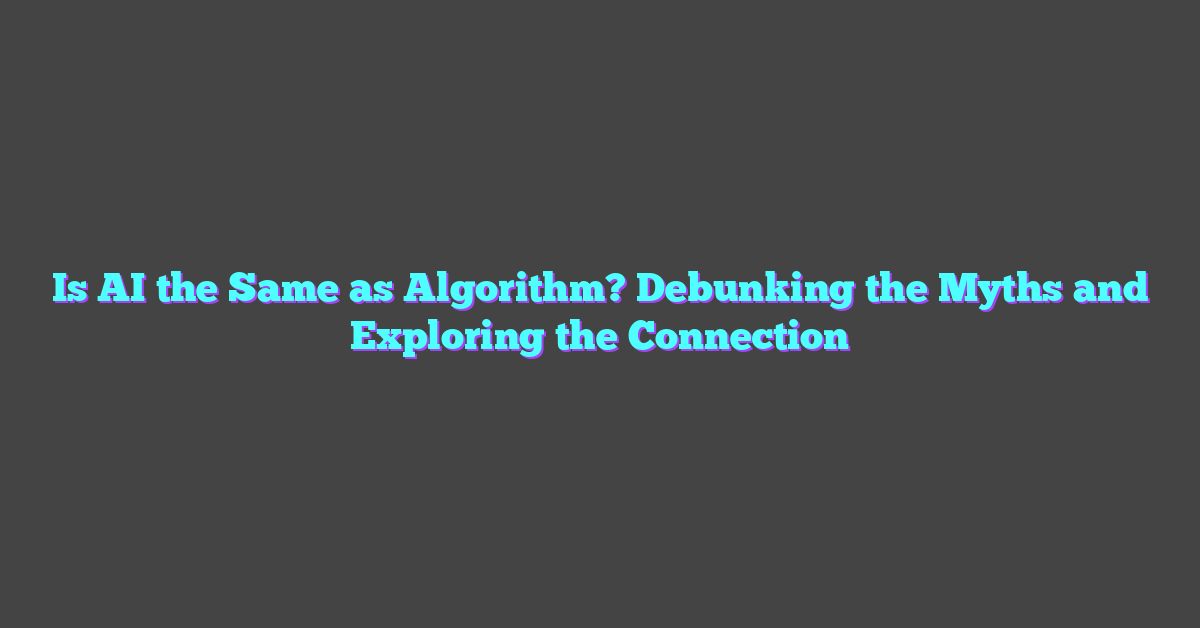When someone mentions artificial intelligence (AI), images of futuristic robots and smart devices often spring to mind. But peel back the sci-fi allure, and you’ll find algorithms at the core. They’re the unsung heroes, the building blocks of AI. Yet, there’s a buzz around town that AI and algorithms might just be one and the same. Are they, though?
In this article, they’ll delve into the intricate dance between AI and algorithms. They’ll explore what sets them apart and where they intersect. It’s a topic that’s not just for tech aficionados but for anyone curious about the digital world shaping their lives. So, buckle up and get ready to unravel the AI-algorithm enigma.
What is Artificial Intelligence (AI)?
Artificial Intelligence, or AI, refers to a field of computer science that’s devoted to creating systems capable of performing tasks that normally require human intelligence. These tasks range from recognizing speech, making decisions, translating languages, to identifying patterns. AI is not just one technology but rather an assembly of technologies working together to enable machines to sense, comprehend, and act.

The expert views AI as a catalyst for innovation, updating traditional processes in every industry. It encompasses a range of technologies including machine learning, natural language processing, robotics, and more. Each technology contributes to the mimicking of human cognition. Machine learning, a subset of AI, enables computers to learn from data, improving their performance over time without being explicitly programmed.
Machine learning is fundamental to AI as it provides systems the ability to automatically learn and improve from experience. Consider it the cornerstone of an AI system. The writer emphasizes that it’s machine learning algorithms that allow AI to digest large quantities of data, learning from patterns and features in the information to make informed decisions. Here’s how AI typically operates:
- Data Input: AI systems receive data from various sources.
- Data Processing: The algorithms analyze the data, looking for patterns or features.
- Decision Making: Based on this analysis, AI makes decisions or predictions.
- Learning: AI systems learn from the outcomes to refine future decisions.
In understanding that AI’s capabilities are vast and growing, enthusiasts and skeptics alike should recognize AI’s transformative potential. With its ability to process and analyze data far beyond human capacity, AI opens doors to advancements in areas like healthcare, automotive, finance, and customer service.
As passion meets profession, the writer is enthralled by how artificial intelligence stands at the forefront of a technological revolution. By sharing this enthusiasm, the aim is to demystify AI and inspire others to appreciate the intricacies of algorithms and the marvels of machine learning.
What Are Algorithms?
Algorithms are at the heart of both AI and machine learning. To put it simply, an algorithm is a set of detailed instructions or rules designed to solve a specific problem or perform a particular task. Think of an algorithm like a recipe in a cookbook, but instead of baking a cake, it’s processing data or solving complex computations.
In the realm of AI, algorithms empower machines to carry out tasks that would typically require human intelligence. They come in various forms and complexities, from simple formulas to sophisticated programs. For example, a search algorithm sorts through massive datasets to find the piece of information you’re looking for with incredible speed and accuracy.
Let’s delve into the types of algorithms used within AI:
- Sorting algorithms organize data, which is essential for functions like search engines and database systems.
- Search algorithms help in locating data within a dataset or determining the optimal route for a problem.
- Machine learning algorithms are particularly riveting because they learn from the data they process. This learning can be supervised, where the algorithm trains on a labeled dataset, or unsupervised, where it makes sense of unlabeled data.
Incorporating machine learning into the mix, algorithms are often categorized based on the learning method or the function they serve. For instance:
- Linear Regression and Decision Trees are used for prediction tasks.
- Neural Networks, inspired by the human brain, are powerful tools for a diverse range of complex functions, from facial recognition to language translation.
- Reinforcement Learning algorithms learn by interaction with an environment, improving their decision-making through trial and error.
These algorithms are central to developing smarter AI systems. They are enhanced continually as more data becomes available and as computational power grows, which in turn enables them to perform increasingly sophisticated tasks. They don’t just follow orders, they learn and adapt, mirroring the essence of human learning—making them a cornerstone for innovation and advancement in AI.
The Relationship Between AI and Algorithms
Delving into the realm of artificial intelligence, one quickly recognizes that AI and algorithms are not synonymous but inherently intertwined. AI encapsulates a broader vision of machines displaying intelligence, while algorithms are the building blocks that enable this sophisticated behavior.
Algorithms are pivotal in teaching machines how to learn from data. They underpin various machine learning models that autonomously improve with experience. In essence, they are the codified experiences that AI systems use to make informed decisions. It’s the meticulous design of these algorithms that propels AI from theory to application. Machine learning experts, impassioned by the mechanics of AI, often celebrate algorithms as the unsung heroes of intelligent systems.
Through the lens of someone who revels in the union of AI and content creation, it’s clear that algorithms allow AI to specialize in diverse applications. For example:
- Sorting algorithms might organize vast libraries of digital content.
- Search algorithms power the quick retrieval of information.
- Machine learning algorithms personalize user experiences by recommending content based on past interactions.
Each type of algorithm serves a distinct purpose but collectively, they form the intelligence of an AI. Furthermore, as AI systems assimilate new data, the algorithms are refined, leading to more accurate predictions and behaviors.
As AI continues to evolve, it demands an increasing level of sophistication from its algorithms. In more complex AI applications, such as natural language processing or autonomous driving, the algorithms must process immense datasets and learn from nuanced patterns. This is where advanced forms of machine learning algorithms, like neural networks, come into play. They mimic the human brain’s structure and function, allowing machines to interpret and react to complex scenarios in real-time.
For AI and machine learning enthusiasts, there’s an unmistakable sense of anticipation for the future, where the refinement of algorithms will unlock even more potential within AI, blurring the distinctions between machine-derived and natural intelligence.
Understanding the Differences
While artificial intelligence and algorithms are often lumped together, they’re distinct concepts each with their own roles and characteristics. Clarifying the disparities between AI and algorithms is crucial for comprehending their individual contributions to the digital ecosystem.
Algorithms are universally applicable across various fields of technology, acting as predefined sets of instructions to accomplish tasks. Whether it’s to sort data, find the shortest path in a network, or predict future events, algorithms are the non-discriminatory workhorses across the tech spectrum. Their essence lies in their deterministic nature, where the same inputs will unfailingly produce the same outputs every single time.
Artificial intelligence, on the other hand, embodies more than just a series of instructions. It’s a dynamic field that leverages algorithms as tools to simulate human cognition and learn from experience. AI systems are designed to adapt, modify, and even create new algorithms as they process new information and learn from it. They’re capable of optimizing their own operations to enhance performance and take actions that appear intuitive.
The varied complexity of AI is a testament to its capabilities that transcend simple algorithmic functions. Consider machine learning, a subset of AI; it’s predicated on the use of sophisticated algorithms that permit systems to learn from and make decisions based on data. Yet machine learning algorithms are a far cry from your basic sorting or search algorithms—they’re complex, can handle ambiguity, and often mimic neural networks found in the human brain.
To illustrate, envision an everyday recommendation system on a streaming platform. While an algorithm may power the retrieval of data, it’s the machine learning model that sifts through viewing history, analyzes user preferences, and iteratively improves its suggestions. These models harness data to unveil patterns and insights that a regular algorithm, operating in isolation, would likely miss. It’s the intersection of machine learning and algorithms where true AI magic happens, resulting in systems that astonish with their seemingly human-like intuition and decision-making.
As AI continues to evolve, it becomes imperative to recognize that while all AI employs algorithms, not all algorithms can claim the title of AI. It’s this nuanced understanding that underpins the expertise required to navigate and innovate in a world where technology is ever-advancing.
Overlapping Areas of AI and Algorithms
When diving into the intersection of AI and algorithms, it’s crucial to recognize their symbiotic relationship. The overlap between these two fields represents some of the most exciting developments in technology.
Algorithms serve as the backbone to AI systems. They are the ordered sequences of operations that guide an AI’s problem-solving capabilities. Simply put, without algorithms, an AI would be like a chef trying to cook a meal without a recipe – it knows the ingredients but not how to combine them effectively.
On the other hand, AI amplifies the utility of algorithms. Through learning and adapting, AI breathes life into these static instructions, allowing for:
- Advanced Pattern Recognition
- Dynamic Problem Solving
- Continuous Improvement through Machine Learning
For example, in machine learning, a subtype of AI, algorithms are designed to learn from data patterns. As they’re exposed to more information, they fine-tune their processes and improve over time. The lines between a preset algorithm and evolving intelligence begin to blur.
Data Processing and Analytics also reveal shared ground. AI uses complex algorithms to sift through massive datasets, identifying trends that would elude the human eye. Faster and more efficient analysis has become the hallmark of machine-assisted data work, offering insights that drive decision-making in businesses and research.
In fields such as robotics and autonomous vehicles, algorithms give AI the sequence of steps necessary to perform tasks, while AI ensures these tasks are adapted and optimized in real-time. The blend of prediction and execution in such areas illustrates the synergistic dance between algorithmic precision and AI’s adaptive ingenuity.
Moreover, the development of neural networks – intricate systems modeled after the human brain – showcases the marriage of algorithmic sophistication with AI’s learning capabilities. Neural networks rely on algorithms to adjust connections based on the input received, constantly learning in a way that mirrors neuroplasticity.
The ingenuity lies not just in having algorithms that an AI system follows but in developing algorithms that an AI can influence and improve upon. It’s at this juncture that technology truly begins to mirror the organic learning experience.
While exploring these overlapping domains, it becomes evident that the fusion of AI and algorithms catalyzes technological evolution, as each pushes the other towards more advanced levels of intelligence and application. The expertise and passion for AI and machine learning drive the ongoing research that contributes to this innovative nexus.
Conclusion
Understanding the symbiotic relationship between AI and algorithms helps demystify the complexity of how intelligent systems operate. They’re not the same, but they’re intertwined, each enhancing the other’s capabilities. Whether it’s through the sophisticated pattern recognition in data analytics or the real-time adaptability in robotics, AI and algorithms together are pushing the boundaries of what’s technologically possible. As they continue to evolve, they’ll undoubtedly unlock new potentials and lead to even more groundbreaking innovations. It’s an exciting time for technology, and the dance between AI and algorithms is one to watch.
Frequently Asked Questions
What is the relationship between AI and algorithms?
Algorithms are the structured sets of instructions that AI systems follow to solve problems. AI enhances these algorithms, enabling advanced pattern recognition and dynamic problem solving, which improves as the AI learns.
How do AI and algorithms work together in data processing?
In data processing and analytics, AI utilizes complex algorithms to analyze large datasets efficiently, recognizing patterns and trends that would be difficult for humans to identify manually.
Can you explain the role of algorithms in robotics and autonomous vehicles?
Algorithms in robotics and autonomous vehicles provide the essential instructions that allow real-time adaptation and optimization of tasks, which AI systems implement to ensure responsiveness and improve functionality.
What are neural networks and how do they involve algorithms?
Neural networks are AI architectures that mimic the human brain’s neurons and synapses. They use algorithms to adjust connections based on received input, facilitating continuous learning and adaptation.




